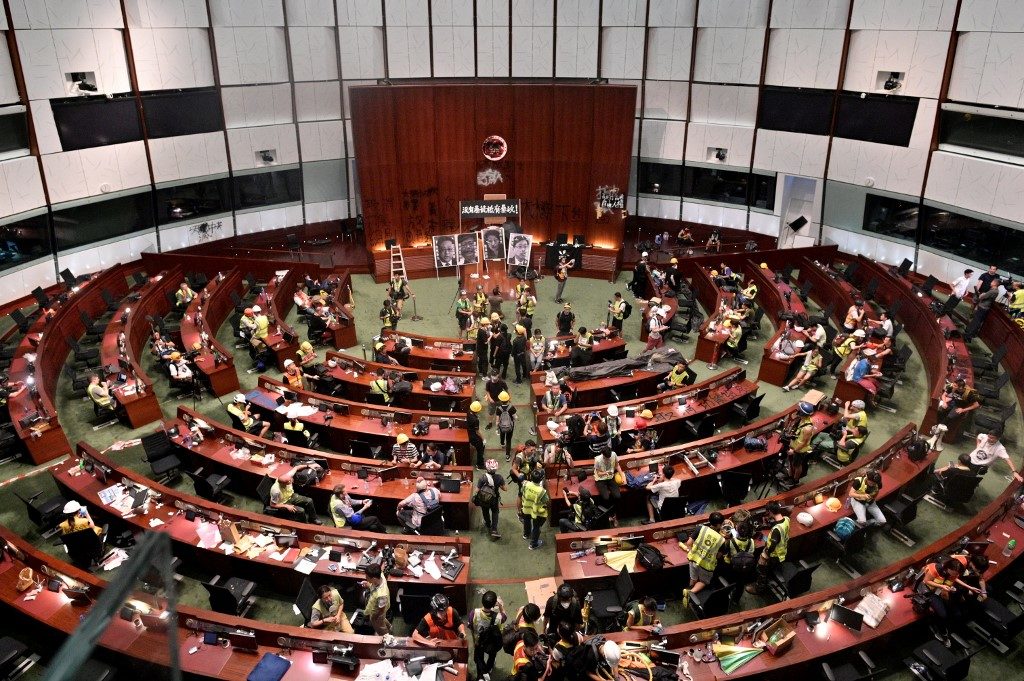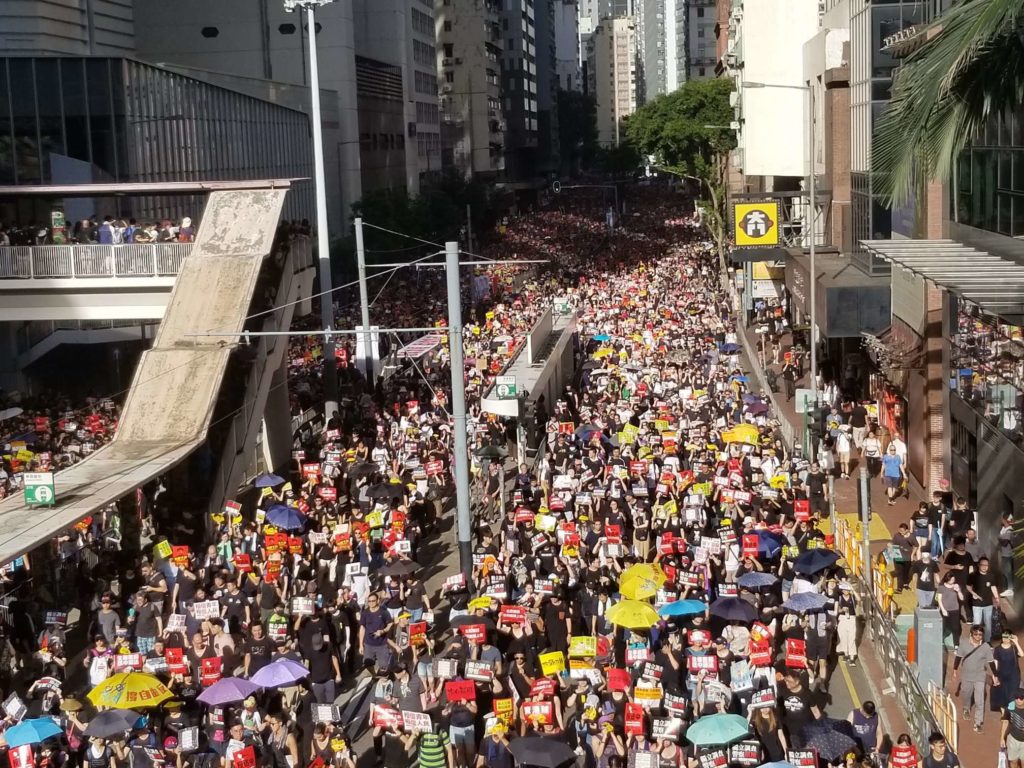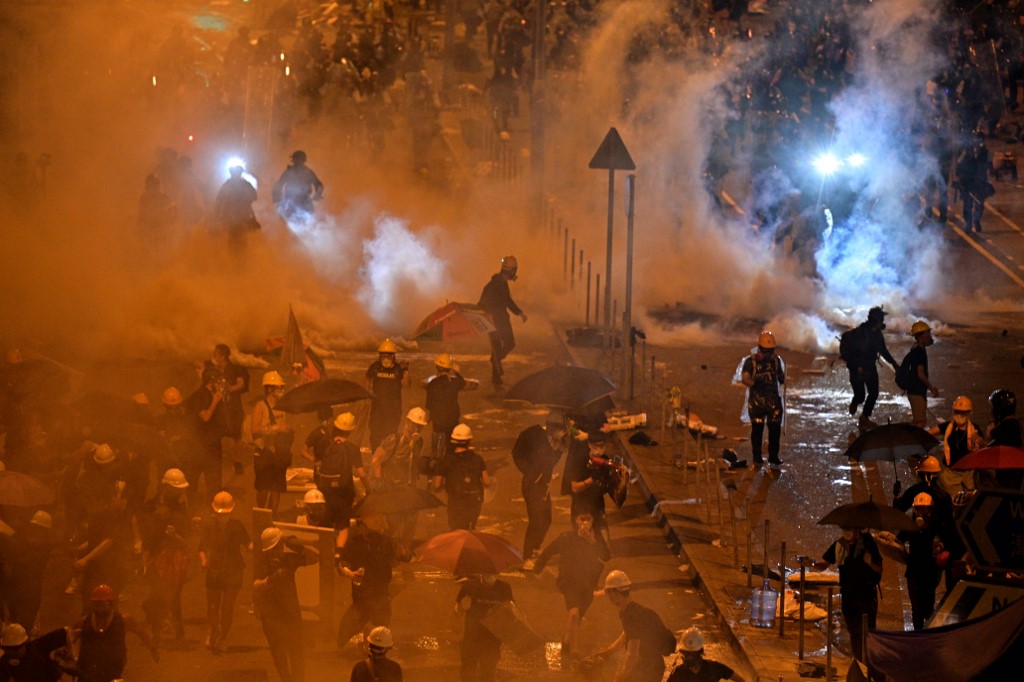Hong Kong riot police finally dropped the hammer on thousands of protesters in the vicinity of Hong Kong’s legislature tonight, firing tear gas and charging barricades as they cleared a massive crowd they had allowed to break into the facility unmolested only hours earlier.
After a brief standoff, a charge behind raised shields saw police crash headlong into protesters, who attempted to hold firm behind barricades thrown up earlier in the day, built in part from materials ripped from the facade of the LegCo itself.
Tear gas canisters are now being fired by #HongKong riot police at protesters on LegCo building's exterior. #NoChinaExtradition #HongKongProtests #反送中 #AntiELAB pic.twitter.com/ailJhr7ctb
— Coconuts Hong Kong (@CoconutsHK) July 1, 2019
Inside the legislative chamber, the scene was equally chaotic, as protesters who had stormed inside of the building and only an hour before had been tossing eggs and spray-painting the city’s Bauhinia emblem, scrambled to make for the exits as word spread of what was happening outside.
The late-night crackdown came after protesters laid siege to to the LegCo for hours, occupying roads, smashing windows, ripping out barriers, throwing eggs, and, finally, storming the building, as crackling, undirected political anger over a controversial extradition bill was taken out on seemingly the only target available: the legislature itself.
Now through the door … https://t.co/jUidWJNJSr #NoChinaExtradition #HongKongProtests #反送中 #AntiELAB
— Coconuts Hong Kong (@CoconutsHK) July 1, 2019
Throughout the day, police largely remained inside the building, and despite multiple warnings to protesters to abandon their more hostile tactics, officers took no steps to intervene with force.
After protesters finally breached the final barriers between them and the LegCo proper, the police inside seemed to dissipate, with protesters allowed to run amok inside the facility. The protesters tied a British colonial-era flag to the parliament podium, defaced the Bauhinia crest of Hong Kong with spray paint, and were videotaped destroying office equipment.
A black and white banner hoisted in the chamber read in Chinese: “Bow to protect rule of law. Oppose extradition.”

Today’s demonstration coincided with the anniversary of semi-autonomous Hong Kong’s return to China by its British colonial rulers in 1997. A ceremony marking the handover and attended by the city’s political elite early this morning was also marred by protests, which police sought to forcibly disperse with pepper spray and batons.
By afternoon, however, the police had largely receded from view, leaving protesters at the LegCo to their own devices.
Meanwhile, across town, a separate demonstration organized by the group behind previous millions-strong marches was also getting underway. Before it reached the intended destination at the LegCo, however, organizers were urging the hundreds of thousands of participants away.

Aware of the tense situation, the Civil Human Rights Front asked marchers instead to end their route at Chater Road, adding that those who wished to head toward the legislature should be prepared to look after their own safety.
Just before police charged protesters’ barricades, the CHRF released a statement blaming the day’s events on the intransigence of embattled Chief Executive Carrie Lam and her administration, which has refused to give in to any of the protesters’ concrete demands, including the full withdrawal of the extradition bill. Presently, the bill has only been suspended.
“Pan-democratic legislators have requested to meet with Lam today to seek solution in this political crisis. But the request of dialogue has been rejected by Lam. We cannot be angrier at her rejection to the request, which proves her “willingness to listen” to be the ugliest political lie,” the statement read. “Lam’s arrogance revealed by her public responses since June 9 have only poured fuel to the flame, and lead to the crisis today. Lam is the culprit.”
Today’s protest was a continuation of the weeks of demonstrations that have rocked Hong Kong since early June, first fueled by widespread fears that the extradition bill could see Hongkongers entangled in the mainland’s notoriously politicized courts, and later galvanized by the heavy-handed police response to an unruly protest on June 12.
That response appeared to win the cause widespread public sympathy, but protests in recent days have taken on a far more disruptive cast, with mostly young demonstrators surrounding police headquarters and occupying government buildings, stymying government workers and everyday Hongkongers alike.
Concerns that such actions could risk turning public opinion elicited initial apologies, but appeared to have evaporated by this afternoon.
So far, it's been a tale of two #HongKong protests. https://t.co/UtGYrxR0BP #NoChinaExtradition #HongKongProtests #反送中 #AntiELAB
— Coconuts Hong Kong (@CoconutsHK) July 1, 2019
“You can say that this is some kind of violence, but that’s all because of the government,” said one protester, who gave his name as Don. “So I think we should use all kinds of methods we have.”
“We tried to protest peacefully, but they wouldn’t listen,” he added, saying that protesters had to do something the government “can’t ignore.”
Indeed some of the actions seemed almost designed to provoke a violent police response, which may, in fact, be the point. In an op-ed for the New York Times yesterday, a self-described Hong Kong protester, Fred Chan Ho-fai, espoused a view calling for “aggressive nonviolence” to provoke an outsized police response to turn the public against the authorities.
“An important idea that has been circulating in online forums is now firmly planted in my mind,” Chan wrote. “It is called the Marginal Violence Theory (暴力邊緣論), and it holds that protesters should not actively use or advocate violence, but instead use the most aggressive nonviolent actions possible to push the police and the government to their limits.”
However, Chan also acknowledged the trickiness of employing such a strategy.
“It’s difficult to calibrate it just right: If the police get violent, we, the protesters, win over a million people — as happened between the marches on June 9 and June 16 — but if the protesters get violent, we lose a million,” he writes.
A protester at today’s march, who gave his name as Ryan, insisted that despite the destruction of property, the protest remained nonviolent and did not have the “characteristics” of a riot.
“We haven’t seen any fire; we haven’t seen a real confrontation between students and the police,” he said a few hours before the crackdown, adding that nonetheless, the effort to storm the LegCo “doesn’t seem very fruitful.”
Following the crackdown, multiple observers were quick to label the police’s willingness to let protesters do thousands upon thousands of dollars’ worth of damage before cracking down a “trap.”
https://twitter.com/jgriffiths/status/1145692175683837952
Among them was pro-democracy lawmaker Fernando Cheung, who said he was “sorry that people played into it.”


